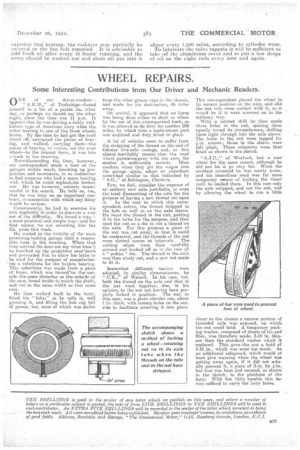WHEEL REPAIRS.
Page 29

If you've noticed an error in this article please click here to report it so we can fix it.
Some Interesting Contributions from Our Driver and Mechanic Readers.
0 NE of our driver-readcrs-" A.H.M.," of Tonbridge—found himself in a bit of a pickle the other day, or perhaps we should say the other night, since the time was 11 p.m. It appears that ho was chiving.a fairly wellknown type of American lorry when the roller bearing in one of the front wheels broke. By the time he had got the road wheel off,-extracted the pieces of bearing, and walked, carrying them—the pieces of bearing, cif course, not the road wheel—to the nearest town, it was two o'clock in the morning.
Notwithstanding te time, however, our correspondent •made a tour of the garages within reach, knocking up proprietors and caretakers, in an endeavour to find someone who had a spare bearing with which he could peplacehis broken one. -He was however, entirely .unsuccessful in his search. lie tells us, too, that he was busy on an important contract, in connection with which any delay would be-serious.
Consequently, the had to exercise his awn ingenuity in order to discover a way out of the difficUlty. He found a way— a most practical and simple way—and for that reason we are awarding him the 15s prize this week.
He 'waited in the vicinity of the most promising-looking garage until a reasonable hour in the morning. When that time arrived (he-does not say what time !) be. knocked up the proprietor once'Wore and persuaded him to allow his lathe to be used for the purpose of manufacturMg a substitute for the broken bearing. This substitute was made from a piece of brass, which was turned'on the-outside ther ame diameter as, the.ontside of the race, bared inside to match the shaft, and cut to the same width as that same race.
He then walked back to the lorry, fitted his " fake' " as he calls it, well .greasing it, and filling the hub cap full of grease, too, most of which was stolen
from the other grease cops jn the chassis, and made for his destination, 45 miles away.
On arrival, it appeared that no harm was being done either to shaft or wheel by the use of this extemporied bush, so it was allowed to do duty for another 200 miles, by which time a replacement part was acquired and duly.fittod in place.
A lot of vehicles seem to suffer from the stripping of the thread on the end of tubular live-axle casings, and, as this almost inevitably means i that the road wheel partsiCompany with the axle, the matter is sufficiently serious. Most readers, when they get the wagon into the garage again, adopt an expedient somewhat similar to that indicated by " S.O.," of Bebingtion, Cheshire.
Few, we find, consider the expense of an entirely new axle justifiable, or even the total dismantling of the axle for the purpose of having a new thread out upon
it. In the case to Which this correspondent refers, the thread stripped in the huh as well as on the axle sleeve. He recut the thread in the nut, putting it in the lathe for the purpose, and then used the nut as a die to cut a thread on the axle. For this purpose a piece of the nut was cut away, so that it could be contracted, and the threads cif the nut were slotted across at intervals. The cutting edges were then carefully _ ground and backed off as in the case of a. " pukka" die. The thread in the axle was then nicely cut, and a new nut made to fit it.
Somewhat different •tactics were adopted, in similar circumstances, by " C.E.," of Walsall. In his CABO, too, both the thread on the axle and that in the nut went together, due, in his 0-pinion, to the nut not having been properly locked in position. The nut, in this ease, was a plain circular one, about 1 in. thick, with tommy-holes on the outside to facilitate screwing it into place.
This correspondent placed the. wheel in its correct position on the axle, and slid the nut into close contact with it, as it would be if it were screwed on in the ordinary way.
With a ratchet drill he then made three holes in the nut, spacing them equally round its circumference, drilling them right through into the axle sleeve. The holes in the nut were tapped for k-in. screws; those in the sleeve were left plain. Three setscrews were then fitted as shown in the sketch.
" S.J.C.," of Watford, lost a rear' wheel for the same reason, although he did not let it go very far. When the accident occurred he was nearly home, and his immediate need was for some temporary rotans of holding the wheel until he landed there. In this case only the axle stripped, and not the nut, and by allowing the wheel to run a little closer to the chassis a narrow portion of threaded axle was exposed, on which the nut could hold. A temporary packing washer, composed of sheets of tin and fibre, -was therefore made, 3-16 in. thinner than the standard washer which it replaced. This gaved.lie nut a hold of 3-16.in., which was none too much. As an additional safeguard, which would at least give warning when the wheel VcaS getting away again, if it did not actually prevent it, a piece of 3-in, by idn. bar iron was bent and secured, as shown in the sketch, to the platform of the lorry. With but little trouble this device sufficed to carry the lorry home.






























